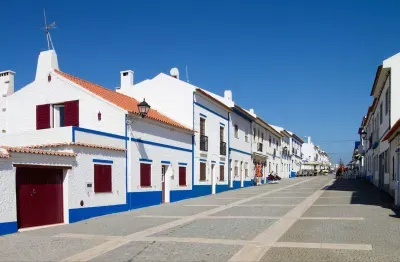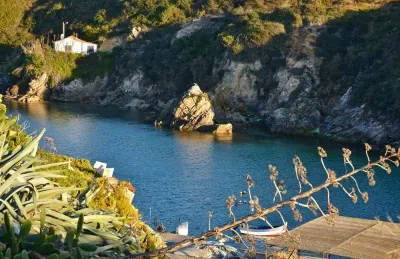
If the archetypal traditional Portuguese fishing village still exists then maybe Porto Côvo is this. Even the name translates as port of the fishing net. A jumble of whitewashed cottages, cobbled streets and pretty squares perched on the low cliff tops of the Alentejo coast between Sines and Vila Nova de Milfontes.
Porto Côvo is undoubtedly pretty but these days it is perhaps best to describe it as a former fishing village since the village's economy is now driven by tourism. Located 170km (just over 100 miles) south of Lisbon, and not far from the main N120 north/south road it is a popular weekend getaway spot during the warmer months. As a result the village has grown considerably with the old centre increasingly surrounded by new holiday villas.

It does get somewhat busy here during the summer holidays with the population increasing by ten times becoming something of a 'Lisbon-on-Sea'. However, it is still less on the tourist map than the neighbouring resort of Vila Nova de Milfontes and attracts more families and Portuguese visitors. Out of season Porto Côvo is a very different place and life feels much has it must have been before the tourist boom.
At the heart of Porto Covo is the attractive cobbled square of Praça Marquês de Pombal which is a nod to the great architect of Lisbon's downtown grid layout, which to a very minor degree has been implemented in this section of Porto Côvo. Unsurprisingly, all roads in the old village lead to the little fishing harbour which clings to the side of a deep natural inlet. A few boats still fish from here but much of the traffic is from boat trips out to and around the nearby Ilha do Pessegueiro.
Translating as Peach Tree Island the actuality of this treeless island is somewhat less romantic than it sounds. Located around 300 metres offshore the island is of some historical interest and is home to both a 15th century fort and Roman ruins.

Perhaps the biggest draw to Port Côvo is the wealth of fine, sandy beaches in and around the village. If you head towards the cliffs at the edge of the village you are sure to find one of a number of sandy coves nestling below. Of these the closest and best are probably Praia dos Buizinhos and Praia do Banho. Both are sheltered by the cliffs but face more or less opposite directions so one or the other are bound to be out of the wind.
Possibly the most popular of Port Côvo's beaches is Praia Grande. Translating as big beach this is certainly the biggest within an easy walk of the village. It is also a Blue flag beach meaning lifeguards and all the facilities you would need for a family day on the beach. Of course if you head a few kilometres north or south you will find some much bigger dune backed beaches that you may well have to yourself.
For keen walkers Porto Covo is one of Europe's best known long-distance trails - the Rota Vicentina. This runs from Santiago do Cacém , just north of Sines, to Cabo Sao Vicente near Sagres covering over 450 km of track. One particular section begins in Porto Côvo, the Trilho dos Pescadores (Fishermen's Trail). As the name suggests this route follows the coast passing Vila Nova de Milfontes, Almograve and Zambujeira before continuing into the Algarve with spectacular scenery en route.